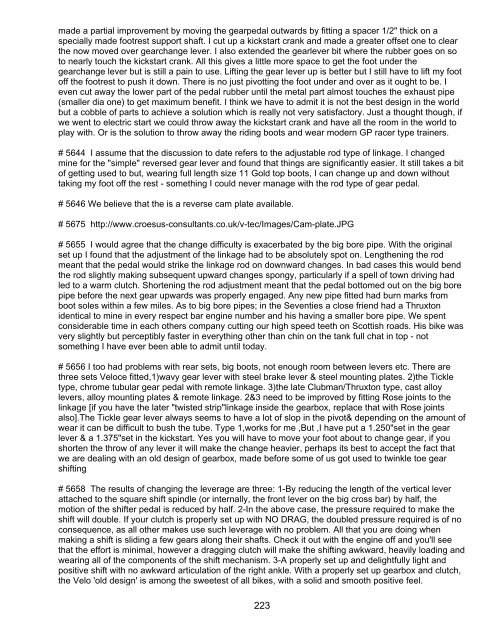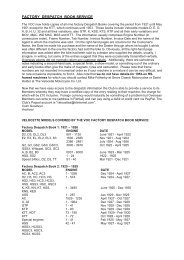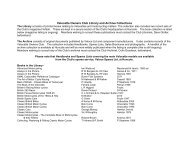The Knowledge - Velocette Owners Club
The Knowledge - Velocette Owners Club
The Knowledge - Velocette Owners Club
Create successful ePaper yourself
Turn your PDF publications into a flip-book with our unique Google optimized e-Paper software.
made a partial improvement by moving the gearpedal outwards by fitting a spacer 1/2" thick on a<br />
specially made footrest support shaft. I cut up a kickstart crank and made a greater offset one to clear<br />
the now moved over gearchange lever. I also extended the gearlever bit where the rubber goes on so<br />
to nearly touch the kickstart crank. All this gives a little more space to get the foot under the<br />
gearchange lever but is still a pain to use. Lifting the gear lever up is better but I still have to lift my foot<br />
off the footrest to push it down. <strong>The</strong>re is no just pivotting the foot under and over as it ought to be. I<br />
even cut away the lower part of the pedal rubber until the metal part almost touches the exhaust pipe<br />
(smaller dia one) to get maximum benefit. I think we have to admit it is not the best design in the world<br />
but a cobble of parts to achieve a solution which is really not very satisfactory. Just a thought though, if<br />
we went to electric start we could throw away the kickstart crank and have all the room in the world to<br />
play with. Or is the solution to throw away the riding boots and wear modern GP racer type trainers.<br />
# 5644 I assume that the discussion to date refers to the adjustable rod type of linkage. I changed<br />
mine for the "simple" reversed gear lever and found that things are significantly easier. It still takes a bit<br />
of getting used to but, wearing full length size 11 Gold top boots, I can change up and down without<br />
taking my foot off the rest - something I could never manage with the rod type of gear pedal.<br />
# 5646 We believe that the is a reverse cam plate available.<br />
# 5675 http://www.croesus-consultants.co.uk/v-tec/Images/Cam-plate.JPG<br />
# 5655 I would agree that the change difficulty is exacerbated by the big bore pipe. With the original<br />
set up I found that the adjustment of the linkage had to be absolutely spot on. Lengthening the rod<br />
meant that the pedal would strike the linkage rod on downward changes. In bad cases this would bend<br />
the rod slightly making subsequent upward changes spongy, particularly if a spell of town driving had<br />
led to a warm clutch. Shortening the rod adjustment meant that the pedal bottomed out on the big bore<br />
pipe before the next gear upwards was properly engaged. Any new pipe fitted had burn marks from<br />
boot soles within a few miles. As to big bore pipes; in the Seventies a close friend had a Thruxton<br />
identical to mine in every respect bar engine number and his having a smaller bore pipe. We spent<br />
considerable time in each others company cutting our high speed teeth on Scottish roads. His bike was<br />
very slightly but perceptibly faster in everything other than chin on the tank full chat in top - not<br />
something I have ever been able to admit until today.<br />
# 5656 I too had problems with rear sets, big boots, not enough room between levers etc. <strong>The</strong>re are<br />
three sets Veloce fitted,1)wavy gear lever with steel brake lever & steel mounting plates. 2)the Tickle<br />
type, chrome tubular gear pedal with remote linkage. 3)the late <strong>Club</strong>man/Thruxton type, cast alloy<br />
levers, alloy mounting plates & remote linkage. 2&3 need to be improved by fitting Rose joints to the<br />
linkage [if you have the later "twisted strip"linkage inside the gearbox, replace that with Rose joints<br />
also].<strong>The</strong> Tickle gear lever always seems to have a lot of slop in the pivot& depending on the amount of<br />
wear it can be difficult to bush the tube. Type 1,works for me ,But ,I have put a 1.250"set in the gear<br />
lever & a 1.375"set in the kickstart. Yes you will have to move your foot about to change gear, if you<br />
shorten the throw of any lever it will make the change heavier, perhaps its best to accept the fact that<br />
we are dealing with an old design of gearbox, made before some of us got used to twinkle toe gear<br />
shifting<br />
# 5658 <strong>The</strong> results of changing the leverage are three: 1-By reducing the length of the vertical lever<br />
attached to the square shift spindle (or internally, the front lever on the big cross bar) by half, the<br />
motion of the shifter pedal is reduced by half. 2-In the above case, the pressure required to make the<br />
shift will double. If your clutch is properly set up with NO DRAG, the doubled pressure required is of no<br />
consequence, as all other makes use such leverage with no problem. All that you are doing when<br />
making a shift is sliding a few gears along their shafts. Check it out with the engine off and you'll see<br />
that the effort is minimal, however a dragging clutch will make the shifting awkward, heavily loading and<br />
wearing all of the components of the shift mechanism. 3-A properly set up and delightfully light and<br />
positive shift with no awkward articulation of the right ankle. With a properly set up gearbox and clutch,<br />
the Velo 'old design' is among the sweetest of all bikes, with a solid and smooth positive feel.<br />
223





